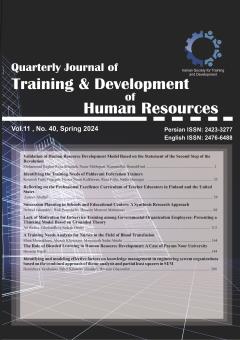-
-
List of Articles
-
Open Access Article
1 - Validation of Human Resource Development Model Based on the Statement of the Second Step of the Revolution
Mohammad bagher Reza alizadeh Nasser Mirsepassi Karamollah Daneshfard -
Open Access Article
2 - Identifying the Training Needs of Pahlavani Federation Trainers
Kurosh Fathi Vajargah Dr Firouz Nouri Kalkhoran reza fathi Nader Barzegar -
Open Access Article
3 - Reflecting on the Professional Excellence Curriculum of Teacher Educators in Finland and the United States
Zohreh Ababaf -
Open Access Article
4 - Succession Planning in Schools and Educational Centers: A Synthesis Research Approach
Behzad Jahanshiri hadi pourshafei Hossain Momenimahmouei -
Open Access Article
5 - Lack of Motivation for In-Service Training among Governmental Organization Employees: Presenting a Thinking Model Based on Grounded Theory
Ali Rafiee Gholamreza Seddigh Oraei -
Open Access Article
6 - A Training Needs Analysis for Nurses in the Field of Blood Transfusion
mina mousakhani Abasalt Khorasani massomehalsadat abtahi -
Open Access Article
7 - The Role of Blended Learning in Human Resource Development: A Case of Payam Noor University
hossien najafi -
Open Access Article
8 - Identifying and modeling effective factors on knowledge management in engineering system organizations based on the combined approach of theme analysis and partial least squares in SEM
HamidReza Yazdanjoo saber khandan alamdari hossein ghazanfari
-
The rights to this website are owned by the Raimag Press Management System.
Copyright © 2017-2025







